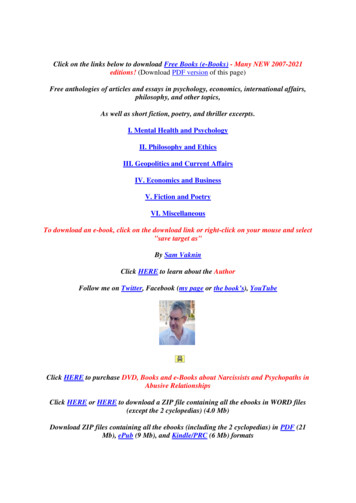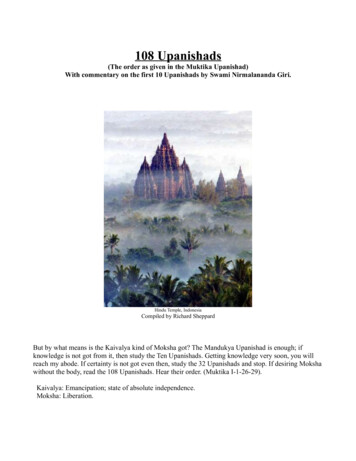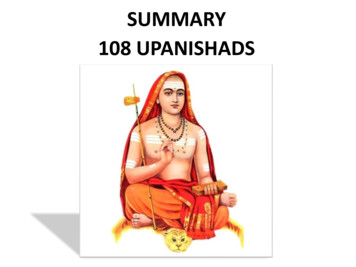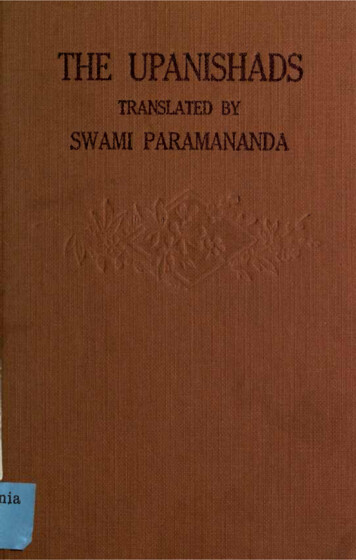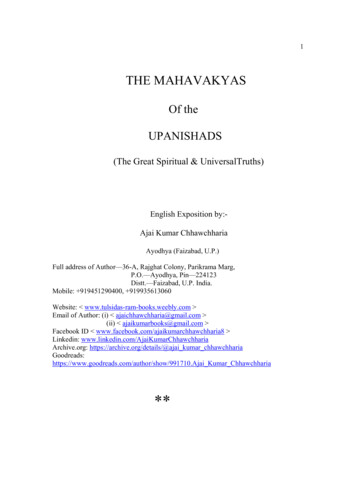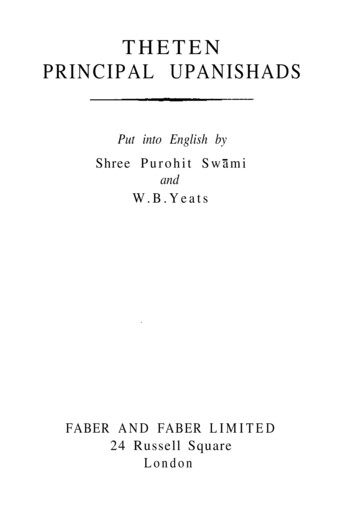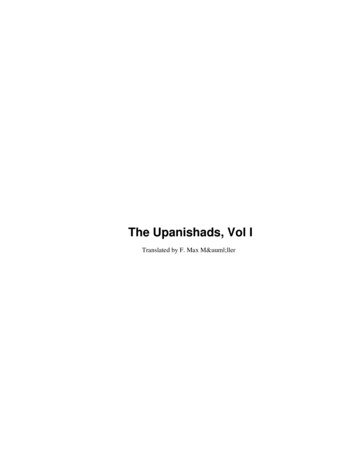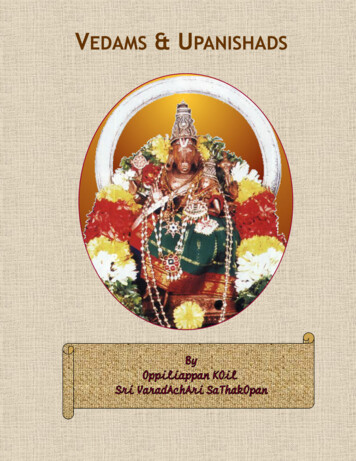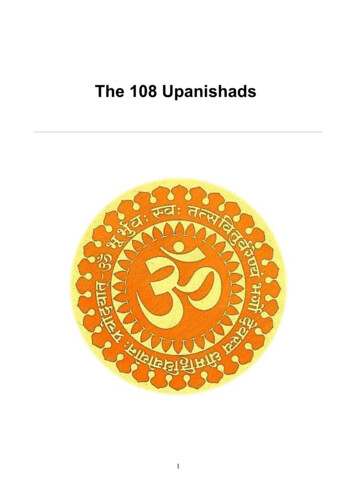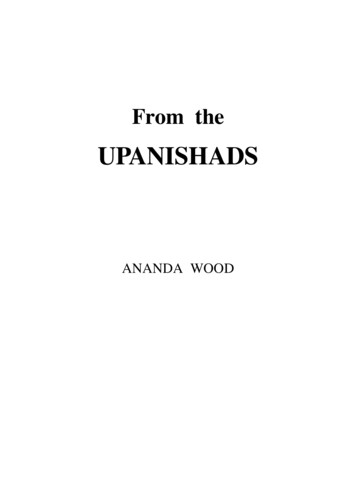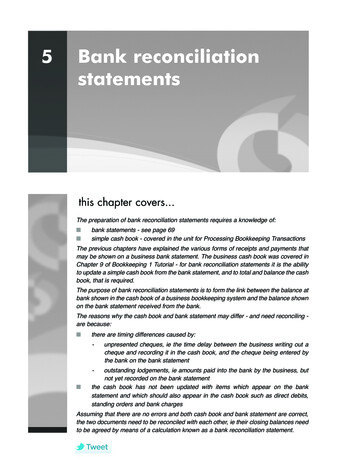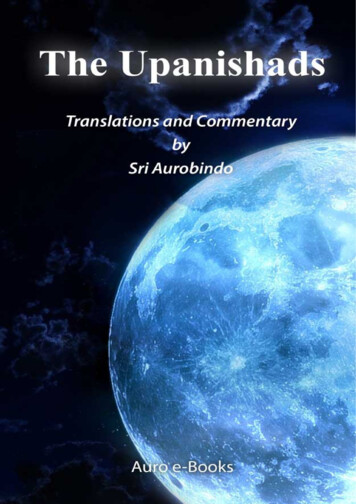
Transcription
The UpanishadsSri Aurobindo
Table of ContentsIntroductionISHA UPANISHADIsha UpanishadAnalysisPrefatory. Plan of the UpanishadFirst Movement. The Inhabiting Godhead: Life And ActionSecond Movement. 1. Brahman: Oneness Of God And TheWorldSecond Movement. 2. Self-RealisationThird Movement. 1. The LordThird Movement. 2. Knowledge And IgnoranceThird Movement. 3. Birth And Non-BirthFourth Movement. 1. The Worlds — SuryaFourth Movement. 2. Action And The Divine WillConclusion and SummaryTHE KENA UPANISHADThe Kena UpanishadCommentaryThe Subject of the UpanishadThe Question. What Godhead?The Supramental GodheadThe Eternal Beyond the MindThe Supreme WordThe Necessity of SupermindMind and SupermindThe Superlife — Life of Our LifeThe Great TransitionThe Parable of the GodsThe Transfiguration of the Self and the GodsA Last WordMUNDAKA UPANISHADFirst MundakaSecond Mundaka
Third MundakaKATHA UPANISHADFirst Cycle. First ChapterFirst Cycle. Second ChapterFirst Cycle. Third ChapterSecond Cycle. First ChapterSecond Cycle. Second ChapterSecond Cycle. Third ChapterREADINGS IN THE TAITTIRIYA UPANISHADThe Knowledge of BrahmanTruth, Knowledge, InfinityNote on the Texts
This e-book had been prepared by Auro e-Books, an international projectdedicated to e-books on Well-Being and Spirituality.Discover more e-books and other activities on our website:www.auro-ebooks.com Sri Aurobindo Ashram Trust 2010Published by Sri Aurobindo Ashram Publication DepartmentWebsite: http://sabda.sriaurobindoashram.org
Publisher’s NoteThe present volume comprises Sri Aurobindo’s final translations of andcommentaries on the Isha and Kena Upanishads, his final translations ofthe Mundaka and Katha Upanishads, and a commentary on part of theTaittiriya Upanishad. They are preceded by a chapter on the Upanishadsfrom A Defence of Indian Culture. These works represent Sri Aurobindo’sUpanishadic interpretation in its most mature and finished form. All werewritten after he settled in Pondicherry in 1910. Translations andcommentaries written before that year, or left incomplete by the author,have not been included in this volume. They are available in otherpublications.The page numbers refer to Section One of “The Upanishads, Texts,Translations and Commentaries”, Second Edition, Pondicherry (1981).
IntroductionThe Upanishads are the supreme work of the Indian mind, and that itshould be so, that the highest self-expression of its genius, its sublimestpoetry, its greatest creation of the thought and word should be not aliterary or poetical masterpiece of the ordinary kind, but a large flood ofspiritual revelation of this direct and profound character, is a significantfact, evidence of a unique mentality and unusual turn of spirit. TheUpanishads are at once profound religious scriptures, — for they are arecord of the deepest spiritual experiences, — documents of revelatory andintuitive philosophy of an inexhaustible light, power and largeness and,whether written in verse or cadenced prose, spiritual poems of an absolute,an unfailing inspiration inevitable in phrase, wonderful in rhythm andexpression. It is the expression of a mind in which philosophy and religionand poetry are made one, because this religion does not end with a cult noris limited to a religio-ethical aspiration, but rises to an infinite discovery ofGod, of Self, of our highest and whole reality of spirit and being andspeaks out of an ecstasy of luminous knowledge and an ecstasy of movedand fulfilled experience, this philosophy is not an abstract intellectualspeculation about Truth or a structure of the logical intelligence, but Truthseen, felt, lived, held by the inmost mind and soul in the joy of utterance ofan assured discovery and possession, and this poetry is the work of theaesthetic mind lifted up beyond its ordinary field to express the wonderand beauty of the rarest spiritual self-vision and the profoundest illuminedtruth of self and God and universe. Here the intuitive mind and intimatepsychological experience of the Vedic seers passes into a supremeculmination in which the Spirit, as is said in a phrase of the KathaUpanishad, discloses its own very body, reveals the very word of its selfexpression and discovers to the mind the vibration of rhythms whichrepeating themselves within in the spiritual hearing seem to build up thesoul and set it satisfied and complete on the heights of self-knowledge.This character of the Upanishads needs to be insisted upon with astrong emphasis, because it is ignored by foreign translators who seek tobring out the intellectual sense without feeling the life of thought visionand the ecstasy of spiritual experience which made the ancient verses
appear then and still make them to those who can enter into the element inwhich these utterances move, a revelation not to the intellect alone, but tothe soul and the whole being, make of them in the old expressive word notintellectual thought and phrase, but sruti, spiritual audience, an inspiredScripture. The philosophical substance of the Upanishads demands at thisday no farther stress of appreciation of its value; for even if the amplestacknowledgement by the greatest minds were wanting, the whole historyof philosophy would be there to offer its evidence. The Upanishads havebeen the acknowledged source of numerous profound philosophies andreligions that flowed from it in India like her great rivers from theirHimalayan cradle fertilising the mind and life of the people and kept itssoul alive through the long procession of the centuries, constantly returnedto for light, never failing to give fresh illumination, a fountain ofinexhaustible life-giving waters. Buddhism with all its developments wasonly a restatement, although from a new standpoint and with fresh termsof intellectual definition and reasoning, of one side of its experience and itcarried it thus changed in form but hardly in substance over all Asia andwestward towards Europe. The ideas of the Upanishads can berediscovered in much of the thought of Pythagoras and Plato and form theprofoundest part of Neo-platonism and Gnosticism with all theirconsiderable consequences to the philosophical thinking of the West, andSufism only repeats them in another religious language. The larger part ofGerman metaphysics is little more in substance than an intellectualdevelopment of great realities more spiritually seen in this ancientteaching, and modern thought is rapidly absorbing them with a closer,more living and intense receptiveness which promises a revolution both inphilosophical and in religious thinking; here they are filtering in throughmany indirect influences, there slowly pouring through direct and openchannels. There is hardly a main philosophical idea which cannot find anauthority or a seed or indication in these antique writings — thespeculations, according to a certain view, of thinkers who had no betterpast or background to their thought than a crude, barbaric, naturalistic andanimistic ignorance. And even the larger generalisations of Science areconstantly found to apply to the truth of physical Nature formulas alreadydiscovered by the Indian sages in their original, their largest meaning inthe deeper truth of the spirit.And yet these works are not philosophical speculations of theintellectual kind, a metaphysical analysis which labours to define notions,
to select ideas and discriminate those that are true, to logicise truth or elseto support the mind in its intellectual preferences by dialectical reasoningand is content to put forward an exclusive solution of existence in the lightof this or that idea of the reason and see all things from that viewpoint, inthat focus and determining perspective. The Upanishads could not havehad so undying a vitality, exercised so unfailing an influence, producedsuch results or seen now their affirmations independently justified in otherspheres of inquiry and by quite opposite methods, if they had been of thatcharacter. It is because these seers saw Truth rather than merely thought it,clothed it indeed with a strong body of intuitive idea and disclosing image,but a body of ideal transparency through which we look into theillimitable, because they fathomed things in the light of self-existence andsaw them with the eye of the Infinite, that their words remain always aliveand immortal, of an inexhaustible significance, an inevitable authenticity,a satisfying finality that is at the same time an infinite commencement oftruth, to which all our lines of investigation when they go through to theirend arrive again and to which humanity constantly returns in its minds andits ages of greatest vision. The Upanishads are Vedanta, a book ofknowledge in a higher degree even than the Vedas, but knowledge in theprofounder Indian sense of the word, Jnana. Not a mere thinking andconsidering by the intelligence, the pursuit and grasping of a mental formof truth by the intellectual mind, but a seeing of it with the soul and a totalliving in it with the power of the inner being, a spiritual seizing by a kindof identification with the object of knowledge is Jnana. And because it isonly by an integral knowing of the self that this kind of direct knowledgecan be made complete, it was the self that the Vedantic sages sought toknow, to live in and to be one with it by identity. And through thisendeavour they came easily to see that the self in us is one with theuniversal self of all things and that this self again is the same as God andBrahman, a transcendent Being or Existence, and they beheld, felt, lived inthe inmost truth of all things in the universe and the inmost truth of man’sinner and outer existence by the light of this one and unifying vision. TheUpanishads are epic hymns of self-knowledge and world-knowledge andGod-knowledge. The great formulations of philosophic truth with whichthey abound are not abstract intellectual generalisations, things that mayshine and enlighten the mind, but do not live and move the soul toascension, but are ardours as well as lights of an intuitive and revelatoryillumination, reachings as well as seeings of the one Existence, the
transcendent Godhead, the divine and universal Self and discoveries of hisrelation with things and creatures in this great cosmic manifestation.Chants of inspired knowledge, they breathe like all hymns a tone ofreligious aspiration and ecstasy, not of the narrowly intense kind proper toa lesser religious feeling, but raised beyond cult and special forms ofdevotion to the universal Ananda of the Divine which comes to us byapproach to and oneness with the self-existent and universal spirit. Andthough mainly concerned with an inner vision and not directly withoutward human action, all the highest ethics of Buddhism and laterHinduism are still emergences of the very life and significance of thetruths to which they give expressive form and force, — and there issomething greater than any ethical precept and mental rule of virtue, thesupreme ideal of a spiritual action founded on oneness with God and allliving beings. Therefore even when the life of the forms of the Vedic culthad passed away, the Upanishads still remained alive and creative andcould generate the great devotional religions and motive the persistentIndian idea of the Dharma.The Upanishads are the creation of a revelatory and intuitive mind andits illumined experience, and all their substance, structure, phrase,imagery, movement are determined by and stamped with this originalcharacter. These supreme and all-embracing truths, these visions ofoneness and self and a universal divine being are cast into brief andmonumental phrases which bring them at once before the soul’s eye andmake them real and imperative to its aspiration and experience or arecouched in poetic sentences full of revealing power and suggestivethought-colour that discover a whole infinite through a finite image. TheOne is there revealed, but also disclosed the many aspects, and each isgiven its whole significance by the amplitude of the expression and findsas if in a spontaneous self-discovery its place and its connection by theillumining justness of each word and all the phrase. The largestmetaphysical truths and the subtlest subtleties of psychological experienceare taken up into the inspired movement and made at once precise to theseeing mind and loaded with unending suggestion to the discovering spirit.There are separate phrases, single couplets, brief passages which containeach in itself the substance of a vast philosophy and yet each is onlythrown out as a side, an aspect, a portion of the infinite self-knowledge.All here is a packed and pregnant and yet perfectly lucid and luminousbrevity and an immeasurable completeness. A thought of this kind cannot
follow the tardy, careful and diffuse development of the logicalintelligence. The passage, the sentence, the couplet, the line, even the halfline follows the one that precedes with a certain interval full of anunexpressed thought, an echoing silence between them, a thought which iscarried in the total suggestion and implied in the step itself, but which themind is left to work out for its own profit, and these intervals of pregnantsilence are large, the steps of this thought are like the paces of a Titanstriding from rock to distant rock across infinite waters. There is a perfecttotality, a comprehensive connection of harmonious parts in the structureof each Upanishad; but it is done in the way of a mind that sees masses oftruth at a time and stops to bring only the needed word out of a filledsilence. The rhythm in verse or cadenced prose corresponds to thesculpture of the thought and the phrase. The metrical forms of theUpanishads are made up of four half lines each clearly cut, the linesmostly complete in themselves and integral in sense, the half linespresenting two thoughts or distinct parts of a thought that are wedded toand complete each other, and the sound movement follows
Upanishads are epic hymns of self-knowledge and world-knowledge and God-knowledge. The great formulations of philosophic truth with which they abound are not abstract intellectual generalisations, things that may shine and enlighten the mind, but do not live and move the soul to ascension, but are ardours as well as lights of an intuitive and revelatory illumination, reachings as well as .
